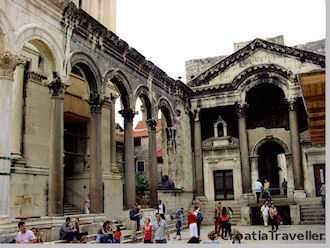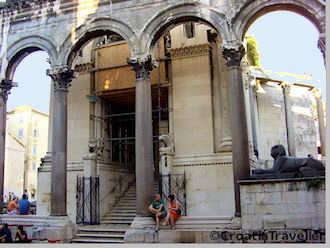Diocletian's Palace in Split is one of Croatia's top sights, a UNESCO World Heritage Site, and a fascinating place to explore. If you're thinking palace like Versailles however, think again because it's really more like a city within a city.
History
Emperor Diocletian was Dalmatia's most outstanding contribution to the Roman empire. When he retired to his birthplace (Salona, near Split) he decided to built this monumental fortified palace.
He began in 295 and for ten years oversaw the quarrying of stone from neighbouring Brac and the construction of his palace. It measures 215m from east to west and the walls are 26m high. Poised between the classical and the medieval Christian civilisation, Diocletian's Palace is a compendium of all the styles that preceded it.
The palace is now a commercial and residential centre, a development which dates to the 7th century when nearby residents fled to the walled palace to escape invading barbarians.
Highlights
The symmetrical layout of the structure with its two intersecting streets is classical but most of the palace reflects the eclecticism of late antiquity. Part imperial villa and part fortified camp, the palace is remarkable for the diversity of forms, which include the octagonal domed mausoleum (Cathedral St Domnius) , the rectangular Temple of Jupiter, the cruciform lower level of the Vestibule, and circular temples to Cybele and Venus. The vast Roman Empire of late antiquity easily absorbed foreign influences, apparent in the Egyptian sphinxes outside the Temple of Jupiter and the mausoleum, rebuilt as the Cathedral of St Domnius.
The ceremonial entrance court is the Peristil (Peristyle), a rectangle measuring 35 X 13m and a few steps below the level of the surrounding streets. The longer sides are lined by six granite columns and two piers with Corinthian capitals; the columns are linked by arches decorated with a stone frieze. In the northeast corner is the small Renaissance church of St Rok, dating from the 16th century. The western side of the rectangle is enclosed by several medieval buildings which fit within the ancient columns. Notice the loggia with Romanesque columns on the Grisogono-Cipci palace.
The southern side of the Peristyle is enclosed by the Protiron, an entrance into the imperial quarters: a triangular gable is supported by four columns with an arch between the two central ones. Under the arch there used to be the imperial loggia. On each side of the Protiron were chapels built between the columns.
Stairs on the left side lead down to the basement halls, which retain a strong sense of grandeur in spite of the many stalls selling local jewelry and crafts.
Diocletian's Palace was named a UNESCO World Heritage Site in 1979 as much for the gothic and baroque buildings that date from the middle ages as for its Roman origins.
It's a great place to visit any time but as darkness descends over the palace and the street life quiets down, it becomes one of Croatia's most romantic spots.
Join the Croatia Traveller Group
Recommended Experiences
©CroatiaTraveller 2005-2024 All rights reserved


